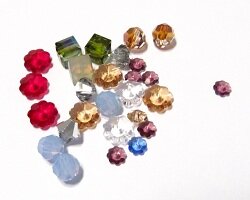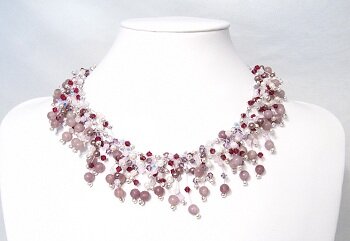|
Contact the seller in advance before paying for the order! Add Glamor To Your Jewelry With Sparkling Crystal
Crystal, no doubt about it, brings sparkle and glamor to your jewelry. Some so glittering that they can be mistaken for diamonds. They give a hint of class, of fashion and luxury. But although they sparkle like diamonds, they are luckily no where close in price. This makes it possible for you to use crystals freely, to create beautiful, glittering creations, getting some of the glamorous feeling that real diamonds would bring on. But what is this marvellous stuff? And what makes it so sparkling and glittering? For thousands of years, all the way back to the great ancient Egypt, glass have been used to make beads. But glass has a flaw, it scratches and breaks easily. It is shiny when bright new, but will be worn out with frequent use. Still it was not until 1673, that someone decided to try to increase the luster and clarity of glass. The process was brought on due to the high price and low accessibility of natural crystals. Whether it was deliberate or by accident, Georg Ravenscroft found that if he added lead to glass during the melting process, the glass became more sparkling and it also made it harder, heavier and thicker than regular glass. He called the invention leaded-glass and patented it. It turned out that led-glass also was ideal for cutting and faceting. Lead made the glass less brittle, allowing more complicated cuts than regular glass. Lead also changed the refraction index of the glass, which made it clearer and brighter. There are however regulations as to how much lead glass MUST contain to be called leaded glass. The British standard is the one the world use to classify leaded glass. It states the following: - Fine crystals must contain between 6-10% lead. So the standard is about how much lead glass must contain to be called leaded glass, and not an upper limit to how much lead you can use before it becomes a health issue. So, I think we can relax about that, and take it that there are no health issues involved. But why do they use lead? According to history, several things were added to glass to imitate natural crystal, and lead just happened to be the one that gave the best result. Lead gives the glass a brilliant, silvery appearance that makes it sparkle when faceted or cut. It increases the amount of light reflected in the glass itself and have light bounce off the leaded glass, making it sparkle. The more lead added, the more it sparkles. When cut or faceted, the outside also makes the light refract more times, so true a leaded glass surface appears flashing when moved even a little. Cheaper beads, like the ones made in China, Taiwan, Japan and India contains less lead than the more expensive Austrian and Czech ones. Since the discovery of leaded glass, there have been several manufacturers producing it. When Georg Ravenscrofts patent expired, most glass producers started producing lead-glass. Today there are still several producers, but only one stand out as the producer of the finest leaded glass in the world today – Swarovski. 
Swarovski: Bohemia, at that time part of the Austrian-Hungarian empire, could not provide the energy he needed in order to use his cutting machine, so he moved his business to Wattenberg in Austria's Tyrol. Using as much as up to 35% lead in the glass, Swarovski soon became regarded as producer of the highest quality leaded glass in the world, and still is today. Swarovski created the now famous Aurora Borealis effect (AB), after he was inspired by the northern light with the same name. This beautiful effect was created in collaboration with Christian Dior. Swarovski has remained in the high fashion starlight, or shall we say crystal-light, and in 1993 the Swarovski company invented a mesh or fabric, where there are more than one million leaded glass beads pr square meter. It became immensely popular within high fashion. Today Swarovski's leaded glass are sold throughout the world. They are considered to be the finest quality full leaded glass ever produced. Swarovsky have a wide range of beads in lots of shapes, colors and finishes. Each cut with a patented facet pattern. Today computer technology makes it possible to program the cutting-machines, allowing hundreds of cuts, pretty much the same way diamonds are cut, allowing light to reflect brilliantly. So, now you know that if you want high quality leaded glass beads, you have to buy Swarovskis. But who is producing the second best? Who else than the company where Swarovski worked as an apprentice when young - Preciosa. Preciosa: The Preciosa led-glass contains proximately 30% led, not far off the Swarovski's, but still far enough to see the difference when you put one Preciosa next to a Swarovski. The swarovski is clearer and more brilliant, no doubt about it.
The good thing is, that if you keep them in good distance from Swarovski, the Preciosa beads are amazingly beautiful and shiny, and will give you very high quality beads. Preciosa coat some of their crystals with special metalic chemicals to achieve different surface effects, among these the Aurora Borealis effect. This makes the leaded glass refract in a rainbow spectrum of color. They also use a foiling process that reduces mistakes in the soldering technique and strengthen the perfect appearance of the bead. Highly resistant varnish is used to protect it during the technological process. Preciosa is one of the most resistant leaded glass beads in the world today. Cheaper leaded glass beads: But what if you don't have a Swarovski or a Preciosa to compare it with? How will you know if you have bought a fake or a genuine Swarovski? Luckily there are some tell tale signs you can look for. 
A true Swarovski bead shall be flawless. There shall be no scratches anywhere and the cut surfaces around the holes shall be smooth. The thickness adjacent to the hole shall be even. In cheaper versions they may be irregular. On a Swarovski the thickness adjacent to the whole is different from one side of the bead to the other. One is thicker and one is thinner. If it has the same thickness around both holes, it is not a true Swarovski. Another way to distinguish cheaper beads from the more expensive ones, are to weigh them. The more lead added, the heavier the bead. China have no guidelines for classifying led-glass, and they do not use the British standard. Therefor you can never be quite sure that Chinese beads contain as much lead as stated, in order to be a true crystal. That's why it may be wise to weigh the beads in order to compare them with beads of higher quality. But, there are no reasons not to buy cheaper leaded glass beads from China, Taiwan and other countries, unless they are made by child labor. It depends on your budget. And sometimes it is better to practice on cheaper beads, and save the expensive ones for more experienced projects. Just know what your buy. There is a lot of fraud around, so try to find a decent dealer that you can trust. If you want to buy Chinese beads, they shall be sold as such. Lead-glass or not lead-glass confusion: How to take care of your leaded glass beads: So, now you know what you can get. When it comes to prices, Swarovski doe's of course top the list. But do not despair, you can get 3 and 4 mm bicones for a fairly decent price. The bigger crystals are of course more expensive, but they ARE truly beautiful. If you cannot afford them, go for Preciosa, if you still want quality. They are a very good substitute for Swarovski, and more friendly in price. When it comes to the Chinese, I don't know. I have not tried them, so I can't really say anything about how much lower in quality they actually are. Some say that they have a good sparkle and clarity, other say that they don't. What they ARE though are cheap, so if you like them, treat them like candy in a candy store: Just dig in! Happy beading! Dangling Lizard Earrings In Silver And Crystal Leave a comment ,I would love to hear your opinion on this page. Good or bad, it will help me making this Site better. |





